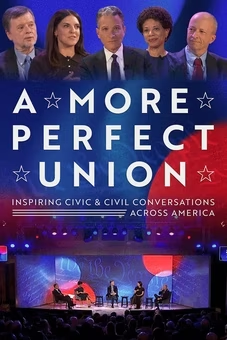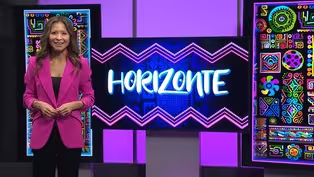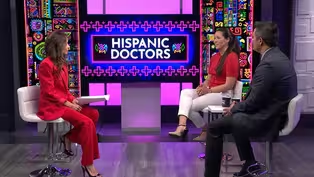
Gentrification and cultural resilience in Latino communities
Special | 16m 17sVideo has Closed Captions
Latinos are confronting an uptick happening in major cities including Phoenix: Gentrification.
Neighborhoods face the challenge of balancing cultural preservation with economic growth amid rising gentrification. Residents are now seeking innovative solutions to protect affordability and maintain their community’s rich identity. "Horizonte" explores their efforts to resist displacement while fostering sustainable development and cultural resilience.
Problems playing video? | Closed Captioning Feedback
Problems playing video? | Closed Captioning Feedback
Horizonte is a local public television program presented by Arizona PBS

Gentrification and cultural resilience in Latino communities
Special | 16m 17sVideo has Closed Captions
Neighborhoods face the challenge of balancing cultural preservation with economic growth amid rising gentrification. Residents are now seeking innovative solutions to protect affordability and maintain their community’s rich identity. "Horizonte" explores their efforts to resist displacement while fostering sustainable development and cultural resilience.
Problems playing video? | Closed Captioning Feedback
How to Watch Horizonte
Horizonte is available to stream on pbs.org and the free PBS App, available on iPhone, Apple TV, Android TV, Android smartphones, Amazon Fire TV, Amazon Fire Tablet, Roku, Samsung Smart TV, and Vizio.
Providing Support for PBS.org
Learn Moreabout PBS online sponsorshipMore from This Collection
From health care disparities to the true cost of a car wash, "Horizonte" examines issues of particular interest to Arizona’s Hispanic community. In partnership with WorkingNation and made possible thanks to the generosity of Lumina Foundation, these specials
The Fight for Puerto Rico's Recovery
Video has Closed Captions
Puerto Ricans tackle hurricanes and energy woes with grassroots farming and renewables. (20m 32s)
Food for Thought: Hispanic Roots and the Next Generation's Impact
Video has Closed Captions
Latino street vendors fight the system for independence and to provide for the next generation. (19m 56s)
'True Cost of a Car Wash' highlights Latino wage theft and economic equality
Video has Closed Captions
Examine harsh realities of wage theft and labor violations in Arizona for Latino American workers. (28m 46s)
The shortage of Latino doctors in Arizona
Video has Closed Captions
It's a frustration many Hispanics in Arizona face: Where are the Latino doctors? (28m 46s)
Providing Support for PBS.org
Learn Moreabout PBS online sponsorship♪ Hey, hey, hey ♪ Hey, hey, hey ♪ Hey, hey (upbeat music) - Hello, I'm Catherine Anaya and welcome to a special episode of "Horizonte".
We wanna take you to Chicago's historic Hispanic barrio, Pilsen and Little Village where generations of Latino families have built a rich cultural legacy.
But now these communities face a growing challenge, gentrification.
In the Working Nation, short documentary “Between Tradition and Translation, Gentrification in Chicago,” we get a closer look at property values rising, and people who've lived there a long time now being forced out, forcing them to find innovative ways to protect their identity and maintain affordability.
While this story unfolds in Chicago, it is a reality for Latino communities across the country, including right here in Arizona, who understand it all too well.
Let's take a look.
- My grandfather was the first person to come from Michoacan, Mexico, to the United States to pick fruit in the 40s, and then my father followed him in the 70s to work in the railroad, to work in the factories, in the logistics and shipping and receiving here in Chicago.
- Chicago is a city that was raised because of working class, manufacturing jobs, industrial jobs, and because of the immigrant population.
And what still unites us is living in the city that many of us have come to feel very passionate, committed, invested in making a better place.
- You know, I had a conversation with my father one day, and I asked him, I said, when you came to the United States, why did you come to Chicago?
what he told me, he was like, you can make home wherever you make community.
And so our job is to be in community and be in right relationship with everyone.
- So the map of Chicago is very much the same over decades.
The north side of Chicago is occupied by people who are white, and then on the south side and the west side of Chicago is where there is majority black and Latinx population.
(soft music) - Little Village is the Meca of the Latino community here in Chicago.
And I say that because of the economic power, because of the political power, because of the cultural power that it has.
This is the central commercial strip (José speaking in Spanish) where people from all the surrounding states come to, you know, to get the groceries.
They come to get their quinceañe and wedding outfits, things that people miss from Mexico, but also things that help them continue to live, and express their Mexican identity and their Mexican culture.
Chicago is on the top index of economics, of tourism, of all these different cultural attractions, and none of that would be available if it wasn't for the Latino community.
So we need to recognize that, and we need to make sure that our role in this community is held sacred and the ability for us to continue to make Chicago home is fought for.
(soft music) (Karen speaking Spanish) (Karen speaking Spanish continue (Karen speaking Spanish continue (Karen speaking Spanish continue - Latino neighborhoods are changing due to gentrification.
The developers and the investors are following the money.
This is capitalism.
This is the way that profits are made.
- [José] What gentrification has been doing is have been pricing out these families from operating their businesses in storefronts, in Little Village in the southwest side of Chicago, has been pricing them out from family run restaurants, been pricing them out from home businesses because of the increased rent, and the increased cost of living in the neighborhood.
So if these small businesses are gone, are eliminated from our neighborhoods, that means that there's just going to be a decrease of jobs.
(Karen speaking in Spanish) - This is where hundreds of vendors used to have small (José speaking in Spanish) here where they would do small businesses, and thousands and thousands of people from Chicago and across the states will come here to buy their things.
This part of land was bought out, and the developer decided to give it an uplift, a facelift to develop it.
And now the vast majority of the people that used to have (José speaking Spanish) there are not there anymore.
Then you see that in the closed storefront.
You see that in less traffic.
And so many of these businesses, family run businesses, businesses by immigrants that employed hundreds of people, where money kept circulating within the community are now gone.
(Karen speaking Spanish) - And what we've seen through gentrification that over one in five businesses in 2021, were shut down, closed.
(José speaking Spanish) So we are seeing a huge burden on individuals in their work, and their inability to be able to provide for their families and build wealth in a way that allows them to take their families into the middle class and progress.
(Karen speaking Spanish) (Hector speaking Spanish) (soft music) (Karen speaking Spanish) (Karen speaking Spanish continue - Here in Pilsen in Little Village, there's a movement for cooperative housing.
Those are some of the policies that need to be supported.
Because what it tells residents is that you are able to not only afford a house and to be able to live here, but you could do it in community.
(Hector speaking Spanish) (Karen speaking Spanish) (Karen speaking Spanish continue (Hector speaking Spanish) (Karen speaking Spanish) (Karen speaking Spanish continue (group singing in Spanish) (Karen speaking Spanish) (Karen speaking Spanish continue - So there are choices that people make, but there's also policies that are creating this larger system that is reinforcing both the segregation of race and ethnicity, but also the segregation economic mobility.
- There are many policy recommendations that are out there.
So for example, the state of Illinois and the governor just passed what are called ethnic business zones, where there are certain tax incentives that the owners of these buildings are gonna be able to provide to maintain those businesses there.
If we lose the Latino community through gentrification or through inequity, or for the inability for us to maintain and buy homes, and then Chicago's not gonna be the great city that it is right now.
(soft music) - As we've seen in Pilsen and Little Village Barrios, balancing cultural preservation with economic development is no easy task.
Yet the fight to maintain affordability and identity is one that Latino communities across the US continue to face, including here in the Grand Canyon State.
The solutions may vary, but the goal remains the same.
To ensure that these vibrant neighborhoods that make up the fabric of our cities remain home to the people and traditions that built them.
I'm Catherine Anaya.
Thank you for watching this special episode of "Horizonte".
(singer speaking in Spanish) (bright upbeat music) (singer singing in Spanish)

- News and Public Affairs

Top journalists deliver compelling original analysis of the hour's headlines.

- News and Public Affairs

FRONTLINE is investigative journalism that questions, explains and changes our world.












Support for PBS provided by:
Horizonte is a local public television program presented by Arizona PBS



